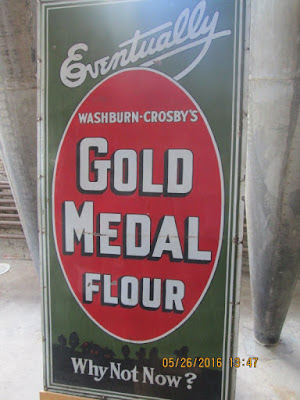Mark and Mary invited me on a tour of the Mill City Museum.
Minneapolis was once the flour-milling capital of the world.
It is a veneration of our 'ancient past'...somewhat like the ruins of the Forum of Rome. Or more likely, a monument to our love for all things freshly baked and slathered in butter.
Loading was an 'entry level' job at the mill, one that required little training and provided few comforts.
Filled barrels weighed 196 pounds and the A Mill cranked out more and more barrels each year--from 1500 a day in 1882 to 5000 in 1890 and 10,000 a day in 1900.
The A Mill shut down in 1965.
This is a millstone.
Millstones work in pairs to grind wheat into flour. Put wheat between two stones, rotate them and grind away. For centuries before the technological advances of the 1880s millstones were the heavy hitters of the flour business. In the end though, millstones could not compete with rollers, which ground the wheat faster and required less maintenance.
This picture is for my sister, Jo.
For those of us who baked, this museum is all nostalgia.
The two flour companies merged in 2001.
And for those of us who ate the products--memories are made of Bisquick....
...Cinnamon rolls...
...I think I have discovered the reason for our obesity problem!
"I baked 17 loaves of bread today, not to mention 21 pies, and puddings, cakes, and doughnuts."
Mary Dodge Woodward
Lunch on a wheat farm during harvest.
"The average price paid to hands is $18 a month and board. In harvest they would get $2.25 a day."
Harper's New Monthly Magazine
The actual Betty Crocker test kitchen...
In 1945 a survey was done by Fortune magazine. First lady Eleanor Roosevelt was ranked the best known woman in America. Second was an entirely fictitious character created 24 years earlier, Betty Crocker.
Products from these two mills could be found in every home in America.
A coupon program was started in 1931 and lasted until 1961, and provided us with a set of Queen Bess silverware that my family used for years.
Part of the museum includes this elevator ride. The visitors were herded into this over-sized elevator cage fitted with chairs and the huge doors closed.
When the doors reopened we were looking at a scene from the early days of the mill.
There were eight floors each with a new presentation and a narrator explaining the history and methods of milling.
The technical parts of the museum were not my favorite but these old guys--all native to the region and mostly wheat growers--were utterly fascinated by the machinery.
At the top of the museum we had a panoramic view of the city...
And another view of that waterfall that is no more.
"Not a trace of it now." That's how John Bacich, author of "The Twilight Years of Minneapolis", described the Gateway District in Minneapolis barely 25 years after the largest downtown urban renewal project of its kind wiped out the city's historic core.
No more dirty flour dust in the air, no wine-soaked derelicts on the streets, no more flophouse hotels and greasy-spoon diners. Now it is the 'in-place' for lunch to be followed by a lovely stroll along the river. (I understand they bake their own bread at the restaurant where we ate.)


































Toni, I've really enjoyed learning about my town by reading your blogs of your visit! You have such a knack for boiling it all down so succinctly, yet your brevity is dense with info as well as twists of humor. Thanks for giving Minneapolis a cool and insightful report! I miss you!
ReplyDeleteThank you for that lovely comment. Keep reading, you are responsible for a lot of what is coming. And Thank You for my lovely visit.
ReplyDelete